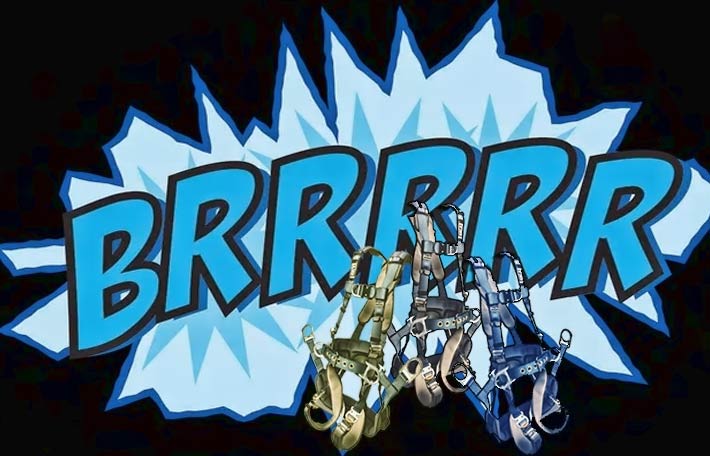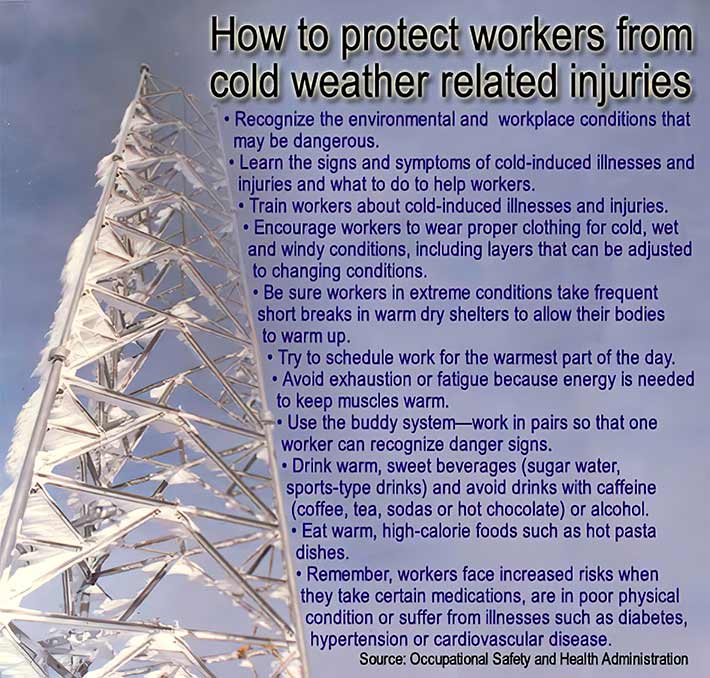
A Georgia tower tech might be cursing the bone-chilling 26° temperature he’s working in this morning in Atlanta.
At the same time, a Fargo, ND tower climber might be pleased with this morning’s weather report of -19° for most of the day in an environment that can see extreme cold temperatures of -70° as it was earlier this morning in Grand Fork.
However, both climbers are equally as susceptible to lose too much body heat causing the inner body temperature to fall to dangerously low levels which can cause hypothermia and even death. Numerous fatalities a year are attributed to hypothermia which results when the body’s internal temperature drops below 95 degrees F.
Although there are no known incidents of tower construction and maintenance workers dying from hypothermia, many frostbite injuries – a cold-related injury characterized by freezing of tissue – have been reported by companies involved in the tower industry. Elevated wind chill factors that climbers will be subjected to must be taken into consideration.
The country has been suffering through a cold snap, but the worst is yet to come as the polar vortex gets displaced from the Arctic Circle and dives into America.
An important tailgate session for tower construction personnel is to discuss first aid for frostbite victims .
Become aware of symptons
It is important to recognize the symptoms. “Pins and needles” will be the initial symptom followed by numbness. There may be an early throbbing or aching, but later on the affected body part will feel like a block of wood.
Frostbitten skin is hard, pale, cold, and has no feeling. When skin has thawed out, it becomes red and painful. With more severe frostbite, the skin may appear white and numb because the tissue has started to freeze.
Very severe frostbite may cause blisters, gangrene (blackened, dead tissue), and damage to deep structures such as tendons, muscles, nerves, and bone.
At -45 degrees F., his workers call it quits
“At 35 degrees below, half of my guys will elect to go off the tower, and at 45 below the rest of them will peel off,” said Kevin Reski, CEO of Great Plains Towers of West Fargo, ND, in a previous interview with Wireless Estimator.
“It’s basically a temperature comfort level that’s allowed for each man,” he said, adding that his company supplies appropriate clothing for cold weather work.
“Everything is black because in the winter it’s our sunniest months of the year. That way you can add another 10 to 15 degrees to your comfort level from wearing black storm coats, sweatshirts and pants,” Kevin explained.
Kevin jokingly adds, “The only time I’ll ever get off of a tower is when I have nobody on the ground to send up any material.”
With his Garrison Keillor-type-humor for cold locale living, Kevin said, “In Fargo, when we get up in the morning and it’s going to be anything above zero degrees, we are so happy, we’re actually ready to go to church on Sunday. We are running out the door besides ourselves.”
Barbara Houdek, CEO of Trillium Development, Inc., a Sartell, MN tower erector and maintenance company, agrees that her climbers should be able to assess on their own when the temperature is too cold to perform elevated work.
Unless it is an emergency, Barbara said in an earlier interview, her employees will not climb in temperatures lower than minus 10 degrees.
“We work all year round, but we’ll typically schedule tower installations in the spring if we can,” Barbara said.
Her employees are outfitted with cold weather clothing which will include Carthartt bibs and jackets as well as face masks and cold weather liners for hard hats. “Bunny boots” for extreme weather conditions are purchased by the climbers.
Scheduling is important, Barbara, explained, so that elevated work can be performed around the warmest part of the day, usually at 2:00 p.m.
Both Barbara and Kevin have had an excellent safety record regarding cold weather injuries. Only minor frostbite has been reported over many years of extremely cold working conditions.
“Perhaps it’s because we take it very seriously in this part of the country,” Kevin said, emphasizing that wherever his crews go they are equipped for any weather condition with multiple sets of clothing.
Barbara stresses the importance of drinking plenty of liquids while working. She says that oftentimes climbers will not realize how much they have been perspiring during the course of the day in below zero temperatures.
First aid for frostbite victims
1. The victim should be removed from the wind and moved to a warmer place. Remove any jewelry and wet clothing. Identify signs of hypothermia and treat accordingly.
2. If immediate medical help and supplies are available, wrap the affected areas in sterile dressings, separating fingers and toes and transport the victim to an emergency medical facility.
3. If immediate care is not available, immediately soak the affected area into warm water (104°F to 110°F). Immerse the affected areas in warm (never HOT) water or repeatedly apply warm cloths to affected ears, nose, or cheeks — for 20 to 40 minutes. Circulate the water to aid the warming process. Severe burning pain, swelling, and color changes may occur during warming. Warming is complete when the skin is soft and sensation returns. If you do not have warm water, hold the affected area against a warm body part (e.g., under an armpit) or warm by breathing out with your mouth on the area.
4. Apply dry, sterile dressing to the frostbitten areas. Put dressings between frostbitten fingers or toes to keep them separated. Elevate the affected area.
5. Never rub or massage the affected area. Never apply direct dry heat such as a campfire or heating pad.
6. Re-freezing of thawed extremities can cause more severe damage. Prevent re-freezing by wrapping the thawed areas and keeping the victim warm. If re-freezing cannot be guaranteed, it may be better to delay the initial re-warming process until a warm, safe location is reached.
7. If the frostbite is extensive, give warm drinks to the victim in order to replace lost fluids.
8. It is important not to smoke or drink alcoholic beverages during recovery as both can interfere with blood circulation.
Wind chill chart should be consulted prior to scheduling work
In using the table below, values of wind chill below -10° F are considered bitterly cold. Values of wind chill below -20° F are extremely cold – human flesh will begin to freeze within one minute.
If reliable weather reports are not available, use the following as a guide to estimate wind velocity:
A 5 mph (8 km/h) wind will move a light flag
A 10 mph (16 km/h) wind will fully extend the flag
A 15 mph (24 km/hr) wind will raise a newspaper sheet
A 20 mph (32 km/h) wind will produce blowing and drifting snow
| Wind (mph) |
Temperature (° F) | ||||||||||||
| 35 | 30 | 25 | 20 | 15 | 10 | 5 | 0 | -5 | -10 | -15 | -20 | -25 | |
| 5 | 32 | 27 | 22 | 16 | 11 | 6 | 0 | -5 | -10 | -15 | -21 | -26 | -31 |
| 10 | 22 | 16 | 10 | 3 | -3 | -9 | -15 | -22 | -27 | -34 | -40 | -46 | -52 |
| 15 | 16 | 9 | 2 | -5 | -11 | -18 | -25 | -31 | -38 | -45 | -51 | -58 | -65 |
| 20 | 12 | 4 | -3 | -10 | -17 | -24 | -31 | -39 | -46 | -53 | -60 | -67 | -74 |
| 25 | 8 | 1 | -7 | -15 | -22 | -29 | -36 | -44 | -51 | -59 | -66 | -74 | -81 |
| 30 | 6 | -2 | -10 | -18 | -25 | -33 | -41 | -49 | -56 | -64 | -71 | -79 | -86 |
| 35 | 4 | -4 | -12 | -20 | -27 | -35 | -43 | -52 | -58 | -67 | -74 | -82 | -92 |
| 40 | 3 | -5 | -13 | -21 | -29 | -37 | -45 | -53 | -60 | -69 | -76 | -84 | -92 |
Wind speeds above 40 mph have little additional chilling affect.
What are the cold weather temperature limits?
Many erectors question what is the unsafe temperature for a climber or civil worker to continue to work in extreme cold weather conditions? While OSHA does not have any regulations specific to working outside in extreme weather, it does publish tips to protect workers in a cold environment. It also states that the contractor must take precautions to protect their workers from life-threatening injuries and ailments.
Whether it is rain, high temperatures, lightning, freezing temperatures or any other working environment that can be extremely hazardous, the job site foreman should assess the conditions and make a decision as to whether his employees should continue to work.
Generally, workers will let their supervisors know when it is too cold. If there is any doubt, it is advisable to move on the side of caution, stop all activities and discuss it with competent professionals. Some company safety and health programs will address policies regarding cold weather work practices.
















